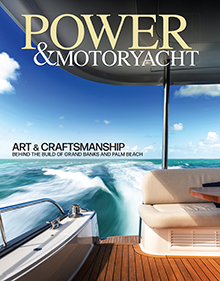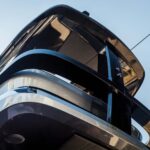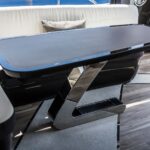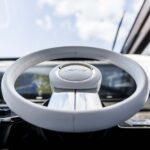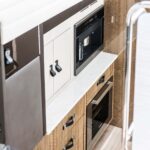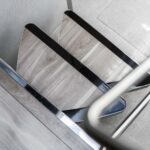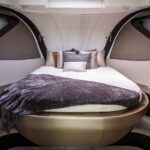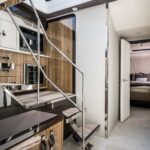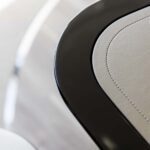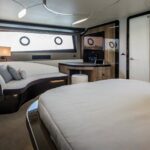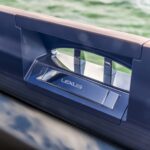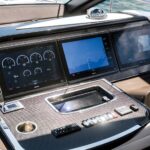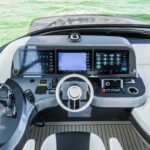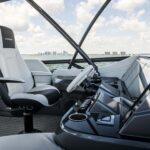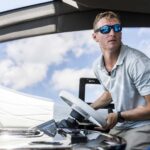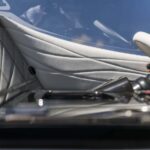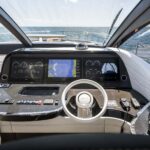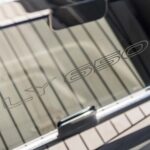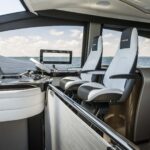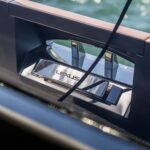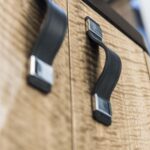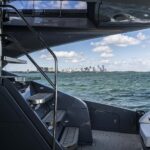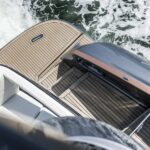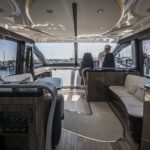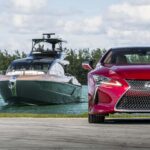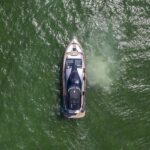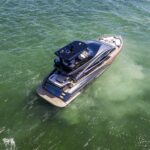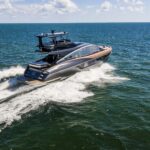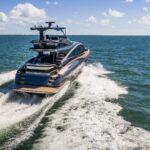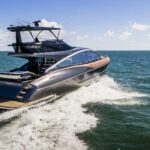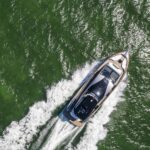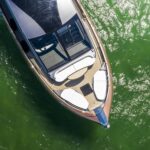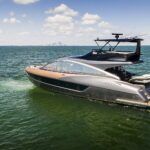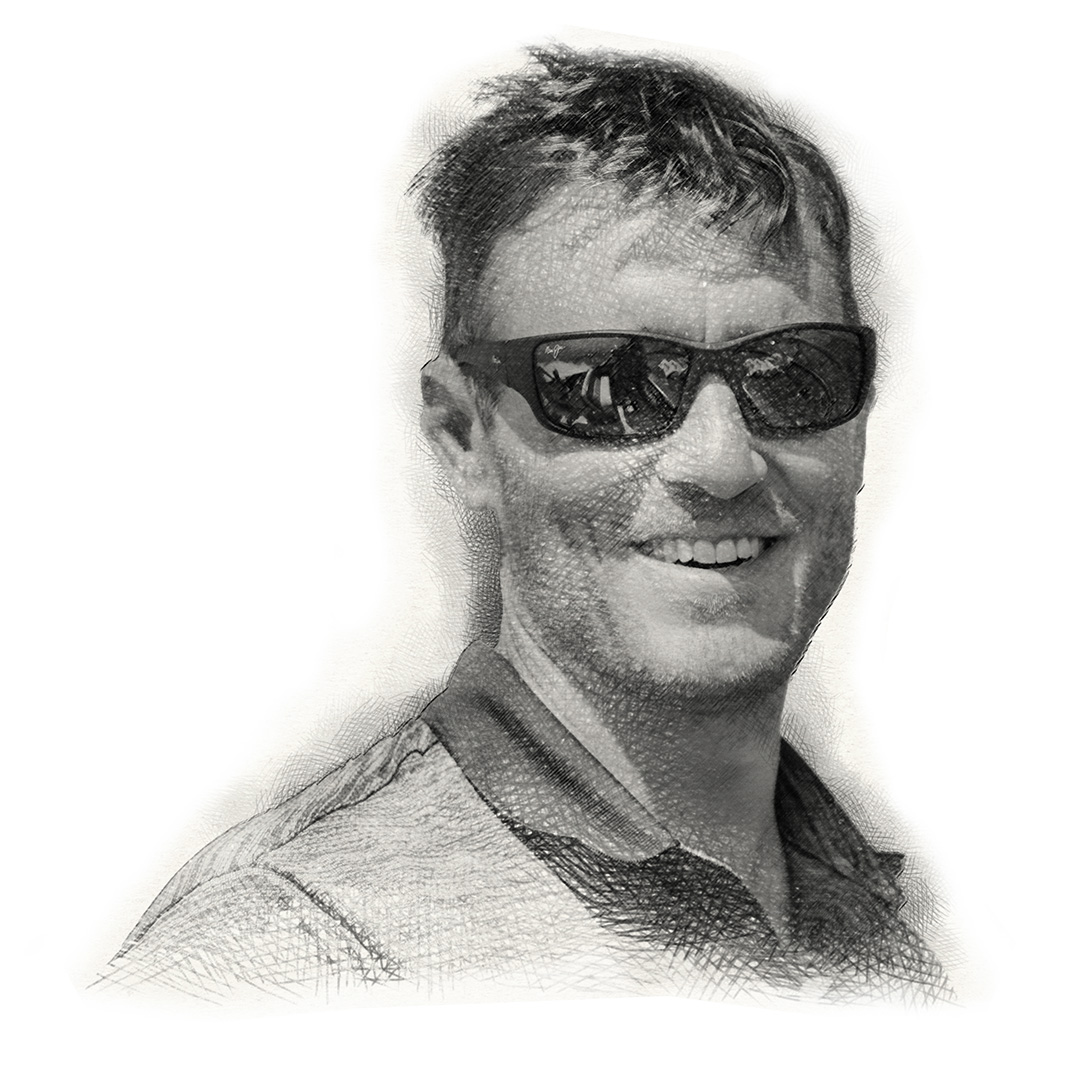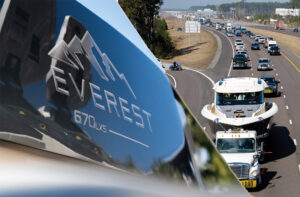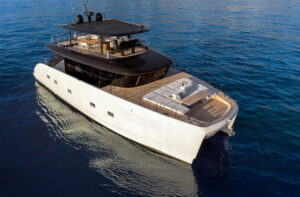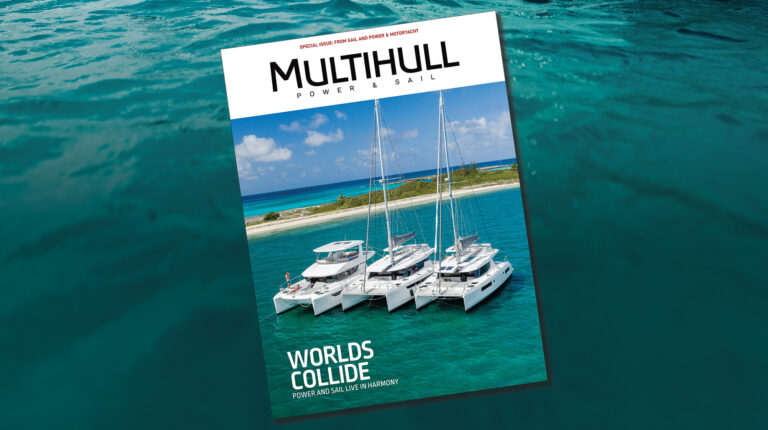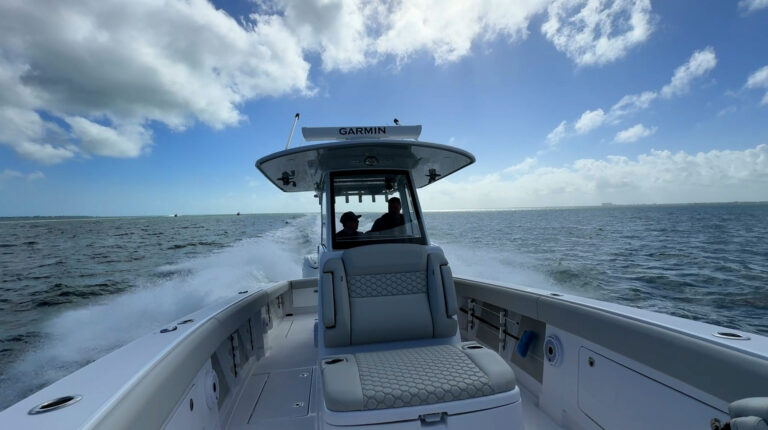Photos by James Lipman
Tested: Lexus LY 650

Car companies trying to break into the yacht market is not a new phenomenon. Not by a long shot. Ferrari collaborated with Riva in 1990 to create the highly anticipated Riva Ferrari 32. Both companies had the capital and the reputation. It was supposed to be the super-crossover to end all crossovers. Only 30 were built.
More recently, Mercedes-Benz partnered with Silver Arrow Marine on a limited-edition sport yacht. Very limited edition. And the Aston Martin AM37 stole hearts on the boat show circuit and achieved social media virality well outside the marine space a couple years back. It seems to have crawled back into obscurity.
Akio Toyoda, president of Lexus’ parent company Toyota, aims to achieve what so many before him have failed to do: add a successful yacht division to a burgeoning portfolio.
Luckily for Lexus, they have precedent in their corner; achieving success against long shot odds is ingrained in Toyoda’s DNA. His great grandfather Sakichi Toyoda, the son of a farmer and carpenter, was an inventor at an exceptionally young age. A curious mind and a healthy dose of perseverance led him to patent a wooden hand loom. A revolutionary breakthrough at its time, it allowed clothes to be woven at a blistering pace. The dye was cast: At just 24 years old, Sakichi Toyoda transformed his first industry.
A lifetime of inventions later, the senior Toyoda earned the moniker King of Japanese Investors. His son stepped out from his father’s shadow to launch the car company we know today as Toyota.
Not one to rest on his laurels—or last name—Akio Toyoda has made it known that he plans to lead his family’s company into the sea and sky.
It’s just after dawn in an empty aquarium parking lot on Virginia Key. My Uber driver must think the unusual drop-off location is the site of a low-level drug deal. He drops me off and quickly departs, no questions asked.

An electrifying red Lexus LC 500 carves a turn out of the lazy, early morning traffic and roars up alongside me. The 471-hp engine is silenced and out steps Pat Devereux, a sharply dressed Brit in blue jeans and a white button-down whose voice you’d recognize from commercials.
A car testing expert and U.S. contributing editor to the BBC’s Top Gear television show, Pat Devereux has thousands of car tests under his belt and possesses a near-encyclopedic knowledge of Lexus sports cars. I asked him to take me through the day in the life of a car tester in order to better understand what Lexus might be able to bring to boating.
“Well, I wouldn’t really call myself an expert, but other people might,” offers Devereux in a British accent that exudes an air of authority. “I’ve been doing this for well over 30 years on four different continents. I’m in the thousands of tests now.”

We exchange small talk for a couple minutes, then quickly pivot to the business at hand. After ogling the car from the exterior, I open the driver’s side door and take a seat behind the helm of the LC 500. My first impression is that the seat is surprisingly comfortable. For such a sleek sports car, I’m surprised that I don’t bang my head when I step in, and that I have plenty of legroom. The comfortable seat would give a helm chair manufacturer like Stidd a run for their money.
“I could use one of these in my office,” I mention to Devereux. “Have any contacts?”
“I think that’s something we can look into,” he replies politely. “Lexus today are always supremely comfortable. They want the driver to be relaxed; a relaxed driver is a good driver.”

Even with all the multi-million-dollar yachts I’ve tested in my career, I notice my pulse beginning to race as I make my way onto the Rickenbacker Causeway. I try my best to exude coolness while also constantly checking my mirrors and keeping my hands at 10 and 2 like a nervous Driver’s Ed student. It’s an awkward combination.
“So what is the most important thing you look for in a car test?” I ask.
“Well, every car is different, and every car has a different mission,” says Devereux. “So I ask myself: Is this vehicle successful in what it’s intended for?”
I bring the car to a respectable cruising speed and take my eyes off the road long enough to inspect the rest of the vehicle. The combination of fabrics—Ultrasuede, carbon fiber and leather—certainly pass the eye test.

“That leather is really nice to the touch and it looks great too,” I offer, while trying not to seem too impressed.
“It comes from cows that are never exposed to barbed wire fences, so their hides stay perfect. Lexus is far, far more exacting than you would ever think.”
“Okay, you got me. I’m impressed.”
Conversation flows from the car’s good sightlines to its carbon fiber top that lowers the vehicle’s center of gravity. I notice similarities between car and yacht design at every turn. We talk about how the trend in cars is a single MFD that replaces gauges and dials.
“I tested a car recently that only had a single button at the dash,” says Devereux.
As our conversation finds its first lull, it’s suggested that we take a stab at some carpool karaoke. To preserve my dignity, I politely decline. But talk of music leads Devereux to point out that a CD player comes standard.
“You’re kidding,” I announce. “In a car like this?”
“You think, ‘Why on Earth would a car like this have something so old fashioned as a CD player?’” says Devereux with a knowing smile. “The answer: audio quality. You can’t get better quality audio than a CD, certainly not better from a Bluetooth system. They want the best quality systems and to provide the best possible experience.”
After cruising with the morning commuters, Devereux says it’s time to exercise my right foot. I look carefully at the open road ahead of me, push the memories of some recent speeding tickets into the back of my mind and press the pedal. 70 … 80 … I look down at the multifunction display and see 96 mph on the screen before I release the beast and bring it back to more publishable speeds. Whether you’re driving a luxury car or running a super console, it’s a sign of a comfortable ride when you fail to realize how fast you’re going. Glad I didn’t have to explain that philosophy to Johnny Law, and not wanting to push my luck, I weave back into the vacant parking lot. The water is calling.
To bring his dream of launching a yacht line to fruition, Toyoda tapped the Wisconsin-based Marquis Yachts. This unconventional marriage didn’t spring up overnight. It was a long courtship between Toyoda and Marquis Yachts CEO Rob Parmentier.
“I worked with Toyoda back when I was at Sea Ray,” says Parmentier. “Since 1999, I was looking into this partnership.” Twenty years later, the intrepid CEO says the timing was finally right.
“Anytime you can combine the passions of people, you’re going to get something special,” he says. “It turns out that we have more in common than we have apart. Our cultures are similar. Where we’re closest is in our work ethic and wanting to do the right thing.”
Parmentier is as passionate as they come in the marine industry. Pride for the new Lexus LY 650 is written on his face like that of a father whose son just caught the game-winning touchdown. But ask him what it was like to work so closely with the Toyota team on this project and he’ll be the first to admit it wasn’t easy.
Toyoda didn’t simply place an order with Marquis Yachts for a 65-footer and wait for his meal to be delivered. If he’s going to put the Lexus name on something, he’s going to be the head chef; he sent supervisors from his company to live in Wisconsin and be on hand to oversee every step of the build.
“It wasn’t smooth off the bat,” laughs Parmentier. “Our average employee has been working with us for 23 years. Sometimes it’s hard to train an old dog to learn new tricks. But their team was on the floor with us every day overseeing our manufacturing and quality control. They instituted their own construction process.” That process, Parmentier explains, is similar to the one that produces cars, in a fanatically efficient and “lean, lean way.”

“When we got our first four to five wins together and my guys could see their jobs get easier and safer, then we started to get everyone on board. It was a three- to six-month tough learning curve boot camp.”
The collaboration didn’t stop with the Marquis Yachts and Toyota teams. That would be too easy. For input on the interior design, they tapped noted Italian designers Carlo Nuvolari and Dan Lenard of Nuvolari Lenard.
When the LC 500 came roaring up to me earlier in the morning, I felt a rush. Reading between the lines and shapes of the car, I could tell the vehicle I was getting into was designed to stand out. I feel a similar rush when I spot the dark metallic color scheme of the Lexus LY 650 behind Monty’s Raw Bar in Miami. Standing apart against a sea of white fiberglass, the first thing I notice is the swooping lines of the boat. There’s not a hard line or edge on this boat’s exterior.
I am admiring the 650’s lines when someone steps down from the restaurant behind me. “It looks like a bullet,” the man says. “Is this a Lexus brand yacht?”
“Yeah, it is. First of its kind.”
“Do you own it?”
“No, unfortunately not,” I reply.
“Too bad,” says the man before returning to his platter of fish and chips.
I would have nearly a half-dozen similar interactions with passersby over the course of the day. The most common refrain when seeing the big Lexus logo on the transom was: “Wow, Lexus builds yachts now? I wonder how it performs.”
It was time to find out.
The 650 salon passes the eye test. Inspect as I might, from the aft galley to the helm to starboard, I can’t spot a single, solitary right angle. Clearly, rounded edges and curves were in the design brief that Toyoda gave Nuvolari Lenard. Walking forward, Devereux points out that the Lexus logo was subtly ingrained in the carpet floor of the salon; it was a reminder of the shared DNA with the auto giant.
Stepping from the salon to the three staterooms below, I stop at a corner nook beside the middle of the flight of stairs. It seems like an odd spot to find an Isotherm wine fridge and Miele coffee station. “I just redid my house in L.A., and this is the same system I got,” says Devereux with a nod of approval. The location makes more sense after I see the massive amidships master with an athwartships berth and a sweeping sofa. It’s a proper lounge hidden from prying eyes dockside (there are going to be gawkers with a boat like this) and the perfect spot to hide away with a cup of coffee or a glass of wine.
In the salon and staterooms, I find a Mark Levinson sound system and remember what Devereux told me about how fanatical Lexus is about their audio systems.

By this point in the day, I’m eager to give Devereux a taste of the boat testing world and to indulge my own fascination. With performance in its DNA, how would this project, conceived by teams on three continents, come together where it matters most? With Devereux beside me at the helm, I deputize him to help me record test data, explaining why sound readings and range are sometimes even more important than top speed in some cases.
The LY 650 climbs to 37.4 knots. A fine turn of speed reminds me of the LC 500.
“It doesn’t feel like we’re going that fast,” I mention while looking at the test notes Devereux scribbled down. “Only 69 decibels,” I say in amazement.
“Is that quiet?” he asks.
“Very.”
I give him a chance at the helm, and enjoy watching him grow more confident as he turns the yacht in tighter circles. I look around for boat traffic as he continues to thoroughly enjoy himself.
I suggest we move things up to the flybridge. “That’s where most people will drive from.”
We do, and the 650 sprints toward the open ocean. With the official test—and Miami—now in our wake, Devereux and I chat about what attracts people to boating. I can tell he’s starting to get it.
“For me, and for a lot of people, it’s all about escape,” I tell him. “It’s about getting away from land-based stress and reconnecting with friends and family in a way that seems rare these days.”
Devereux nods and looks off at the horizon. I can tell he feels the same way when he’s behind the wheel of a car.
“What are you looking for now?” he asks as I cruise aimlessly.
“Honestly,” I reply, “I’m just driving for the fun of it and thinking about a question you asked earlier: Is this boat successful in what it’s intended for? I think it is.”

When setting out on this new, waterborne endeavor, Akio Toyoda’s goal for the 650 was to achieve what the Japanese call omotenashi. In a word, it symbolizes how the Japanese value attention to detail and how they try to anticipate the needs of their guests.
Will Lexus succeed where so many automakers have failed before? Can a car manufacturer become a major player in the yacht market? I think it just might—and not because Lexus came to market with some flashy, out-of-the-box concept. I think they’ll be successful because they decided not go it alone; they knew they were inexperienced in this field, and tapped proven partners to help. Choosing a boatbuilding partner like Marquis Yachts gives this new line a sturdy foundation; utilizing Nuvolari Lenard’s design expertise was a brushstroke of brilliance. When you have partners like those, and mix in a steadfast attention to detail and drive for perfection, that’s how you build a boat with international appeal. That’s how you build a boat with omotenashi.
Lexus LY 650 Test Report

Lexus LY 650 Specifications:
LOA: 65’5″
Beam: 18’8″
Draft: 5’6″
Displ.: 73,500 lbs.
Fuel: 1,000 gal.
Water: 225 gal.
Standard Power: 2/800-hp Volvo Penta IPS1050
Optional Power: 2/900-hp Volvo Penta IPS1200
2/1,000-hp Volvo Penta d13 IPS1350

